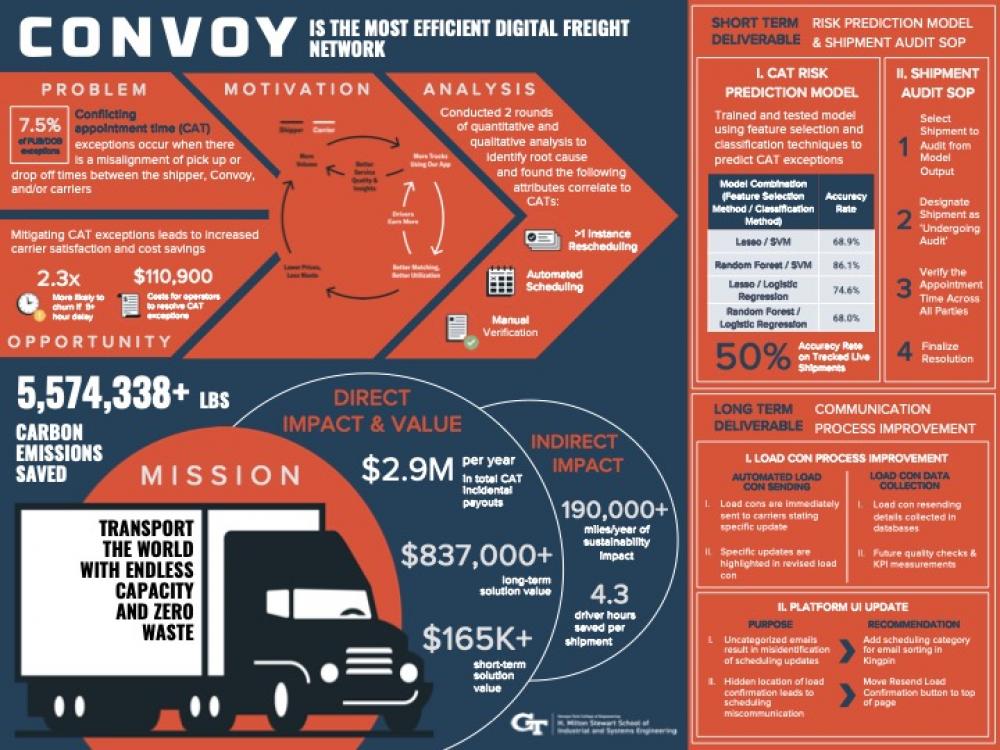Client Context
Convoy is a digital freight company based in Seattle working to build technology that finds smarter, more efficient ways to connect shippers with carriers across the country. Founded in 2015, Convoy's mission is to "transport the world with endless capacity and zero waste" by eliminating deadhead miles, or miles traveled by truckers carrying no shipment load. Deadhead miles constitute 35% of the miles travelled by truckers, and Convoy has eliminated 5,561,754 lbs. of carbon emissions since its founding. As a digital freight broker, Convoy works actively to ensure that each shipment is completed seamlessly between each party using a mix of automated and manual processes that receive and schedule shipment tenders, perform quality verifications, post information to the app, and match carriers to shipments. This project supports Convoy's Process Design and Improvement (PDI) team. This department designs and refines the engineering and supply chain processes that improve shipper and carrier experiences while reducing costs.
Project Objective
Exceptions are issues that prevent shipment execution and must be resolved through Convoy intervention. The goal of this project is to mitigate conflicting appointment time (CAT) exceptions that occur during shipment pick-up and drop-off and as a result increase overall carrier satisfaction. CAT exceptions occur when shippers and carriers are misaligned on the appointment time of a shipment's load execution. CAT exceptions have accounted for a significant portion of load execution exceptions, leading to unwanted incidental payouts to carriers. With a projected increase in shipment volume over the next year, Convoy will incur increased operational costs and decreased carrier satisfaction rates if the rate of CAT exceptions remains steady. Convoy is looking to disrupt an extremely saturated industry, and an increased focus on the carrier experience will help it compete with the 106,870 other freight brokerage corporations. Truck drivers can easily churn to another platform for a variety of reasons, and Convoy carriers are more likely to churn if they experience a delay on a particular shipment. Identifying the root cause of CAT exceptions is crucial to designing and implementing preventative measures to reduce wait times, incidental payouts, and carrier dissatisfaction resulting from CAT exceptions.
Design Strategy
To better understand the scope of CAT exceptions, trend analysis was conducted on past shipments that incurred CAT exceptions to determine the magnitude and complexity of the issue. Despite collecting over 1,000 data points for each shipment on the stop level, Convoy did not have an initial hypothesis for the underlying cause of CAT exceptions. The team identified specific shipment attributes that were disproportionately present in shipments with CAT exceptions and conducted deep dives, or thorough quantitative and qualitative analyses, to further solidify the findings. This information led to the development of both a short-term solution to proactively prevent CAT exceptions on ongoing shipments and a long-term solution to systematically mitigate the issue.
Deliverables
In the short-term, a predictive shipment risk model will identify shipments at high risk of having a CAT exception and utilize a standard operating procedure (SOP) to ensure all parties agree on the appointments. In the long-term, systematic recommendations include automated load confirmation notifications when shipment updates are made and user interface updates to Convoy's internal operations platform. These changes will streamline communication and workflow for both carriers and Convoy operators and reduce instances of misalignment. Short Term Trend analysis showed correlations between certain shipment attributes and CAT exceptions, which were used in a machine learning model to predict CAT exception occurrences on current shipments. By implementing (1) a prediction model for identifying CAT exceptions and (2) an SOP for verifying the predictions, the team aimed to proactively prevent CAT exceptions from impeding load execution. The CAT Risk Prediction Model is used to flag incoming shipments that are at risk of incurring a CAT exception. Historical shipments are used to accurately train and test the model. Data cleaning was necessary to utilize the data features. The cleaned data then underwent feature selection through one of two possible techniques, Lasso Regression and Random Forest, to reduce the features down to significant ones. The training data was used to fit the model using supervised classification through one of two possible techniques, Logistic Regression or Support Vector Machine, to indicate whether a shipment will incur a CAT exception. The model was validated using a testing dataset and outputs a list of shipments at risk of experiencing a CAT exception. When operators receive the list of shipments to audit, they must follow the Shipment Audit SOP to ensure that the appointment time is accurately confirmed across all parties. This document serves as a second verification and includes the necessary steps to mitigate potential exceptions. The SOP was verified with Convoy operators and tested with account managers as a successful way to identify and prevent CAT exceptions without adding time to operator workload. Long Term Most CAT exceptions had the following three common characteristics: >1 instances of rescheduling, automated scheduling, and a manual verification process. The rescheduling instance showed the most significant correlation to CAT exceptions compared to the other identified shipment attributes. As a result, designing rescheduling system improvements presented an opportunity to reduce the number of CAT exceptions over the long term. The team presented Convoy with recommendations for systematic improvements that included internal UI platform updates, communication process improvements, and recommendations to automate a specific rescheduling process.


